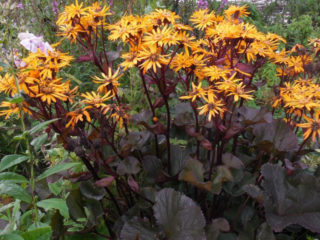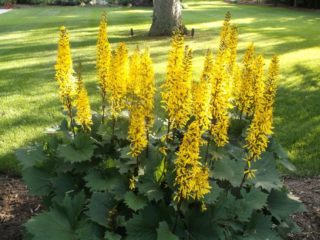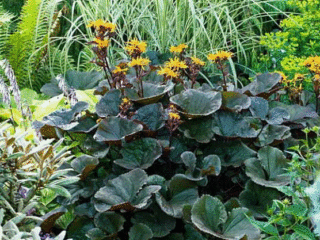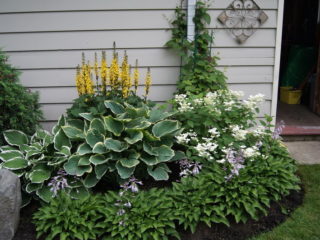Content
Buzulnik Vich (Ligularia veitchiana) is a perennial from the Astrov family and belongs in its biological genus to the group with pyramidal inflorescences. The first description of this species was given by the British botanist William Hemsley. The plant has decorative qualities, therefore it is used in landscape design.
Description of the species
Buzulnik Vicha is from the western regions of China. Due to its decorative effect, this species is popular in horticulture. It has been cultivated since the beginning of the 20th century.
Buzulnik Vich is a powerful upright plant.
Its main characteristics:
- height up to 2 m;
- the stem is thin, but strong and tough;
- high spike-shaped inflorescences, bloom from bottom to top;
- flowering begins in August, lasts more than a month;
- disc flowers in large numbers, yellow;
- yellow baskets, up to 6.5 cm in diameter;
- flowers have 12-14 tongues, oblong shape, length up to 2.5 cm;
- foliage dark green, smooth and bare on both sides;
- basal leaves up to 30-40 cm in length and 35 cm in width, heart-shaped, edges with sharp teeth, characteristic elasticity and shine;
- petiole length 45-60 cm, semi-cylindrical shape;
- fruit - an oblong achene with a tuft;
- high cold resistance - the plant can withstand frosts down to - 29 ° C;
- decorativeness throughout the season.

In Buzulnik Vich, both flowers and leaves have decorative properties.
Application in landscape design
Buzulnik Vich, thanks to its large leaves, looks good in single plantings. It can be planted on a lawn, placed under a tree or near a pond.
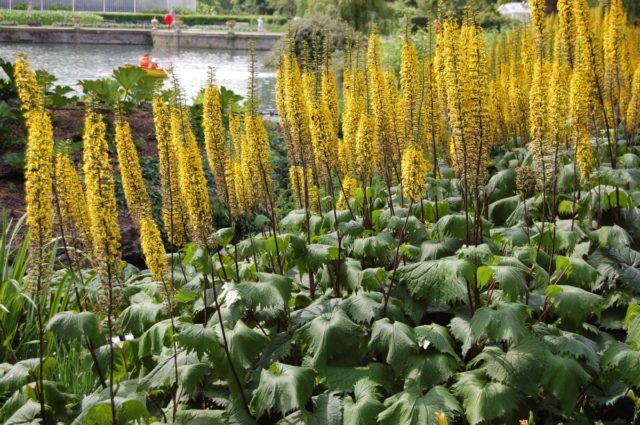
Buzulnik Vich is hygrophilous, therefore it grows well near natural and artificial reservoirs
Buzulnik Vich also looks spectacular in group plantings. It can be combined with a variety of green and flowering plants. For harmony in the shape of the inflorescences, its neighbors can be: spikelet veronica, willow loaf, lupine, fennel grate (fennel), foxglove and Transylvanian sage.
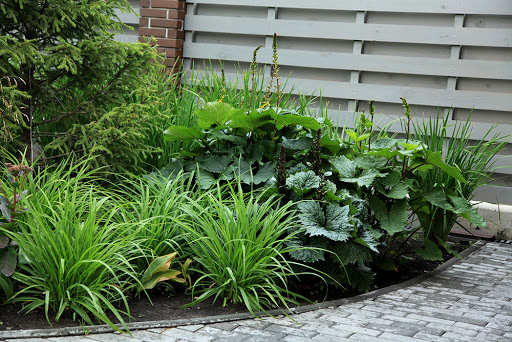
Buzulnik Vich effectively plant along paths, fences, various buildings
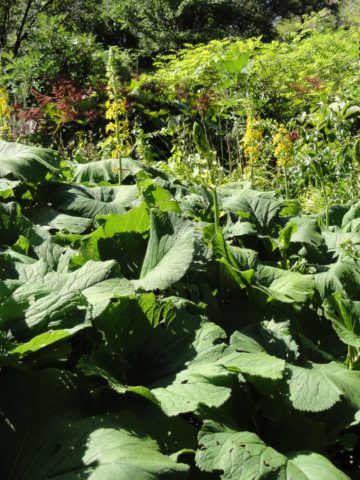
The leaves and inflorescences of Vich Buzulnik are suitable for cutting
Breeding features
You can propagate Vich's buzulnik by seeds or by dividing the bush. The second method can be used throughout the season, but it is better to plan for May or September-October. When planting in spring, the plants take root better.
Vich Buzulnik seeds can be harvested by yourself. To do this, you need to wait until they are fully ripe. It is convenient to wrap the inflorescences with gauze. After that, the seeds need to be dried and put in paper bags.
It is not difficult to divide the bush:
- Select a plant and carefully dig it up. This measure is optional, you can simply separate the desired part with a shovel.
- Rinse the bush with water.
- Divide it into pieces with a knife. Each must have a bud of growth. Treat the sections with crushed charcoal or potassium permanganate solution.
- Plant the cuttings on a dug and fertilized area. Deepen them so that the growth buds are 3-5 cm above the surface.
When propagated by seeds, the buzulnik begins to bloom only after 3-4 years. When dividing, this happens already in the next season.
Planting and leaving
Buzulnik Vich is planted in open ground with seeds. Growing seedlings is not required.
Buzulnik needs comprehensive care.It can include pruning to maintain the decorative effect of the plant. You need to get rid of wilted peduncles.
Recommended timing
Buzulnik Vich seeds are planted in spring or autumn. Better to plan work for May.
The plant can also be planted with seedlings. This should be done in the spring.
Site selection and soil preparation
In order for Vich's buzulnik to grow successfully, develop and retain its decorative effect, it is necessary to choose the right place for its planting. It must meet the following requirements:
- partial shade, although it is permissible to place the bushes in the sun if you water them regularly and abundantly;
- the soil is preferable light and loamy, rather loose and moist;
- the acidity of the soil is neutral, a slightly acidic or slightly alkaline reaction is allowed.
The area chosen for the buzulnik must be dug up, sinking into the bayonet of the shovel. Loosen the surface thoroughly.
In addition to fertile garden land, when planting, you need humus - 1 bucket for each seedling. From fertilizers add wood ash and superphosphate.
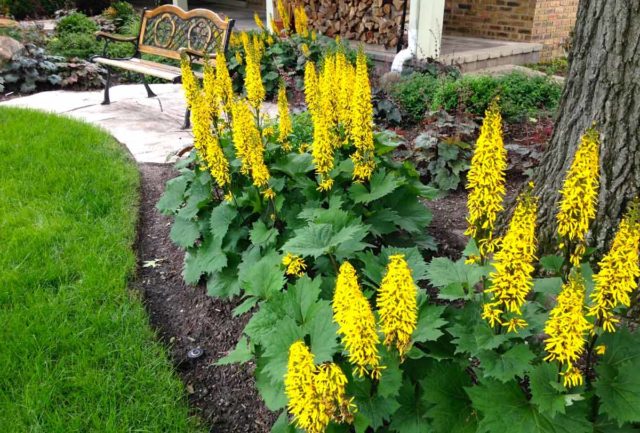
Buzulnik is convenient to plant under trees that provide the necessary shading
Landing algorithm
Planting Vich's buzulnik is not difficult. If you grow it from seeds, then the algorithm is as follows:
- Prepare the site.
- Make grooves or holes.
- Sow seeds, sprinkle with earth and compact it. Deepen by 2 cm.
- Cover the garden bed until spring before winter.
When planting a buzulnik in autumn, the seeds undergo natural stratification. As the plant grows, it is necessary to thin out. As a result, at least 0.5 m should remain between the bushes.
Watering and feeding schedule
Buzulnik Vich is hygrophilous, therefore it must be watered often and abundantly. It is enough to do this once a week. On dry days, watering is increased, producing every 3-4 days. If the air is too dry, then the plants should be sprayed in the morning or in the evening so that they retain their decorative effect.
The first feeding is carried out when planting plants, when humus, wood ash and superphosphate are introduced into the soil. Then the buzulnik needs 2 dressings per season:
- mullein solution (10%) - apply under each bush by the end of spring;
- humus in the fall at the end of flowering.
Loosening and mulching
During the season, the soil near the bushes must be loosened. This should be done after watering or rainfall. The first loosening is carried out in the spring, as soon as the snow melts, and the frost has passed.
Less loosening of the soil will be required if its surface is mulched. Better to use humus or peat. The mulch will retain moisture at the roots and inhibit the growth of weeds.
Preparing for winter
Buzulnik Vich is cold-resistant, therefore it survives the winter well. Special preparation for it is not required, except for pruning at the root for the first frost.
Shelter should only be done in regions with harsh winters or little snow cover. In other cases, preventive mulching with needles or tree bark is sufficient.
Diseases and pests
One of the attractive features of Vich Buzulnik is its resistance to diseases and pests. The main problem of the plant is slugs. They feed mainly on young leaves. There are several methods of dealing with these pests:
- mechanical obstacles - mulching with stone chips, pine needles, ash, crushed nuts or eggshells, ash;
- chemical composition - granules with metaldehyde "Thunderstorm", powder of aluminum sulfate;
- traps - a plastic glass buried in the ground with beer or milk (pour only on the bottom), cabbage leaves or wet burlap spread on the surface;
- natural enemies are birds, lizards, toads.
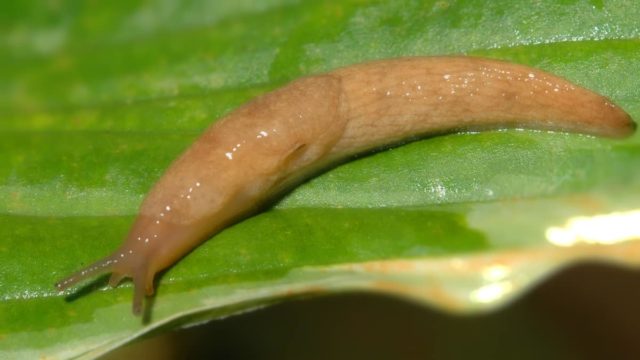
For the prevention of slugs, autumn cleaning of the garden and burning of plant residues are important.
Buzulnik Vich can suffer from powdery mildew. This is a fungal disease, which must be fought with fungicides - copper sulfate, Fitosporin, Topaz. The prevention is the burning of plant residues.

The main sign of powdery mildew is white bloom on the leaves.
Conclusion
Buzulnik Vich is an unpretentious perennial that is easy to grow in the garden. It can be planted with seeds or seedlings, propagated by dividing the bush. It is easy to take care of it, all activities are standard for garden plants.


